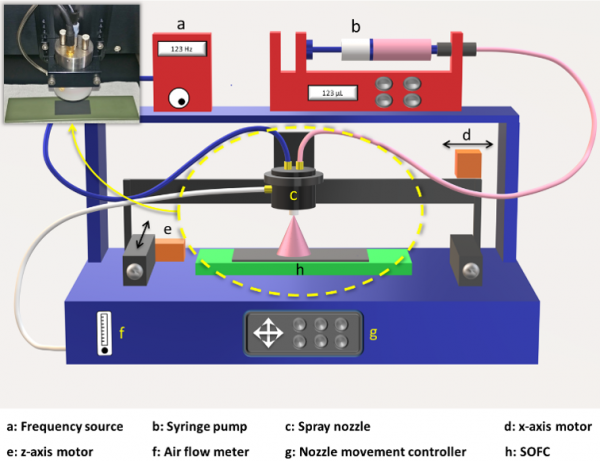The ultrasonic dispersion liquid infiltration method uses a homogeneous catalyst nano-coating technology to improve the durability of the solid oxide fuel cell (SOFC) at lower temperatures. The research team led by Dr. Seung-Bok Lee and Dr. Rak-Hyeon Song from the Fuel Cell Laboratory of Korea Energy Research Institute stated that the performance of SOFC is more than doubled by using ultrasonic dispersion liquid infiltration method. SOFC works at high temperatures and has the highest power conversion efficiency among existing fuel cells, exceeding 60%. The catalyst solution is used to accelerate the chemical reaction between hydrogen and oxygen. The most important factor that determines the overall performance of the SOFC system is the battery cell composed of anode, electrolyte and air electrode. The slow reduction of oxygen at the cathode is one of the reasons for the deterioration of SOFC battery cell performance. In the existing micropipette method, the droplet is larger than 1 mm, which hinders the inflow of oxygen and reduces efficiency. To solve this problem, the researchers developed an ultrasonic dispersion liquid infiltration process. This process is a technology that uses an ultrasonic device to quantitatively apply a uniform catalyst layer and can reduce the size of the droplets added by fine shaking to 0.01mm. Many studies have used a liquid infiltration method in which a catalyst is dissolved in a solution and added to the cathode layer to improve the oxygen reduction reaction, in which oxygen is introduced from the outside to meet electrons. In the traditional microtube liquid infiltration method, the size of the added droplets is larger than 1 mm, and the catalyst condenses on the surface of the cathode, preventing the inflow of oxygen, thereby reducing performance. Through the ultrasonic wet infiltration process, it is determined that the SSC nano-catalyst layer is grown on the existing SOFC cathode material LSCF layer, and its performance improvement effect is about 2.3 times that of the existing LSCF/GDC composite cathode. In addition, transmission electron microscopy analysis confirmed that the SSC nanocatalyst layer grown on the LSCF cathode has the same crystal structure. The SSC nanocatalyst layer grown with the same crystal structure not only inhibits the growth of particles, but also exhibits excellent long-term durability through good adhesion with LSCF. Dr. Seung-Bok Lee said: "This is a technology suitable for commercialization. It is easy to be used in large-area SOFC batteries and can form new nano-catalyst functional layers in newly developed batteries and existing batteries. Nanometer The catalyst layer can be used as an important research result to improve the performance of SOFC in the future." (Original from: Fuel Cell Engineering China New Energy Network) Touch Kitchen Faucets,Touch Kitchen Faucets Price,Touch Kitchen Faucets Product Yuyao Zelin Sanitary Ware Co., Ltd , https://www.zelinsinkfaucet.com
